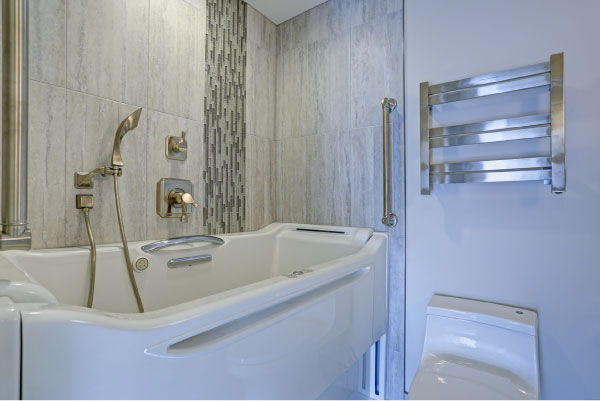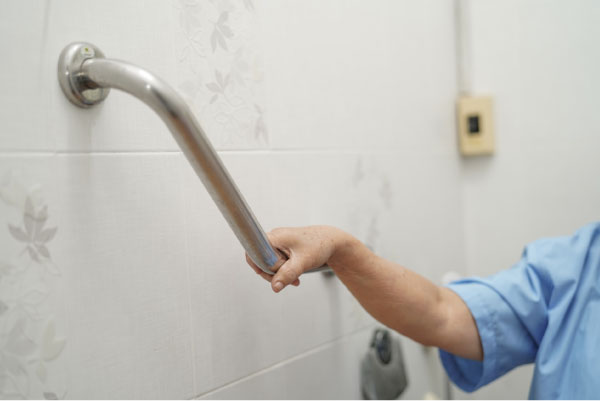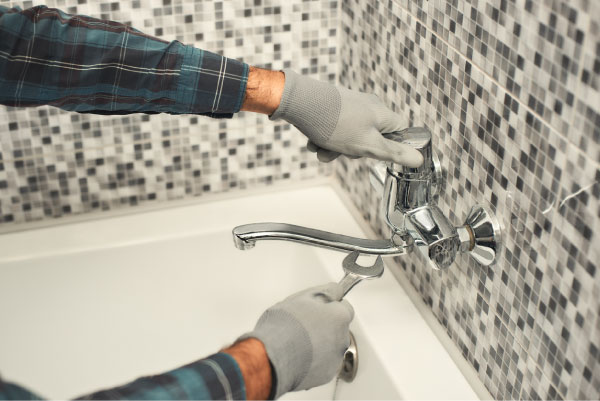
Helping seniors age in place requires home modifications to accommodate their reduced physical abilities. For older adults, the slippery surfaces in the bathroom mean that a senior bathroom makeover can be key to aging in place safely. According to the Centers for Disease Control (CDC), more than a quarter of seniors age 65 and older fall each year. Many of those falls happen when while entering or exiting the tub.
Difficulty with self-care, including personal hygiene, is one of the primary reasons many seniors enter assisted living. Walk-in tubs allow users to safely and easily enter and exit the tub through a door on the front. They reduce the risk of dangerous falls and help older adults to live independently at home.
However, a walk-in tub can be considerably more expensive than a regular tub or roll-in shower. Unfortunately Medicare generally does not cover walk-in tubs, so you must carefully consider the best type of walk-in tub for your health requirements, your bathroom design, and your budget.

What type of walk-in tub is best for your needs?
In one sense, all walk-in tubs are the same in that they allow the user to walk into the tub enclosure or transfer into the tub from a wheelchair without climbing over a barrier. Beyond that, though, you can choose between multiple options to find the one that’s right for your needs, home layout, and budget.
- Soaker: This is closest to a basic bathtub. It allows users to sit and bathe independently. The only difference is that it has a door in the front and safety bars. The soaker is the least expensive type of walk-in tub. Prices range between $2500 and $5000.
- Aerotherapy (Air Bath): These tubs provide a gentle massage from air bubbles that stream from the sides or the bottom of the tub. It’s both relaxing and therapeutic. The gentle motion of the water helps improve circulation. Prices range between $5,000 and $7,000.
- Hydrotherapy: This is like having a walk-in hot tub, with targeted jets that provide deeper massage for joints and muscles than air bath models. Prices range between $5,000 and $7,000.
- Bariatric: These larger tubs have enough space for a caregiver to help someone with significant mobility issues enter and exit the tub safely. They’re also suitable for larger people weighing 300 pounds or more. Bariatric walk-in tubs have wider doors and more room than standard tubs. They also cost more. Prices range between $15,000 and $20,000.
- Other options: There are many other types of walk-in tubs, including two-person tubs, combination walk-in shower/tubs, and so-called luxury tubs with amenities like aromatherapy. Those can cost $15,000 and up, depending on options.
Remember to consider installation costs; they can add $2500 or more to the cost, depending on the tub and your home layout. Some manufacturers include installation charges in their price quote, so make sure you know what is included in the quoted price.
Things to consider before you choose your walk-in tub
Walk-in tub type is a very personal choice, but there are also important practical considerations.
- Size: A basic walk-in tub can often be installed in place of an existing tub, while a larger one may require extensive bathroom remodeling. Remember that regular tubs come in a variety of sizes. Measure yours before choosing a walk-in tub.
- Structural requirements: Walk-in tubs are heavier than regular tubs. They can weigh over 1,000 pounds when filled. Make sure your floor is strong enough to bear the load.
- Plumbing: If you have older plumbing that’s not up to current building codes, your walk-in tub may fill and drain more slowly. Fill and drain speed is an important metric because you have to be in the tub while both take place.
- Hot water heater: Most walk-in tubs don’t use significantly more water than a regular tub, but if you select a bigger tub than your current one, you may need to move up to a larger volume water heater.
Most people purchase a walk-in tub because they have mobility problems or other health issues that make self-care difficult. However, remember that soaking in a hot tub for extended periods can raise your heart rate and lower blood pressure. It can be dangerous for people with certain chronic conditions, like heart disease. Look for a tub with a scald prevention valve that prevents extremely hot water from entering the tub.

Who are the leading manufacturers of walk-in tubs?
Not surprisingly, some of the leading manufacturers of bathroom fixtures also make walk-in tubs. There are also companies that only manufacturer walk-in tubs and other assistive home equipment.
- Kohler Walk-In Baths
- American Standard Walk-In Baths
- Jacuzzi
- Boca Walk-In Tubs
- Safe-Step Walk-In Tubs
- AmeriGlide Walk-In Tubs
- Independent Home Walk-In Baths
I don’t own my home. Is there an alternative to a walk-in tub?
Property managers generally won’t allow tenants to modify the structure of the home or apartment. Most tenants don’t want to spend thousands on something they have to leave behind when they move.
In that situation, a bath or shower chair may be a good alternative. Prices range between $50 and $300. They come in a variety of sizes and configurations – and you can take them with you when you move! Learn more about how to choose the best shower chair.







